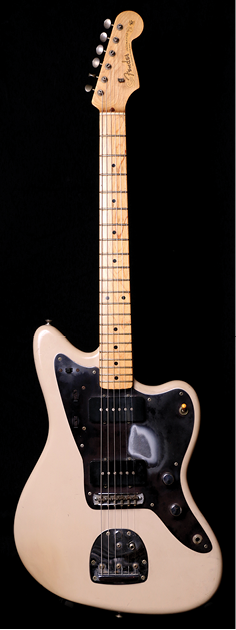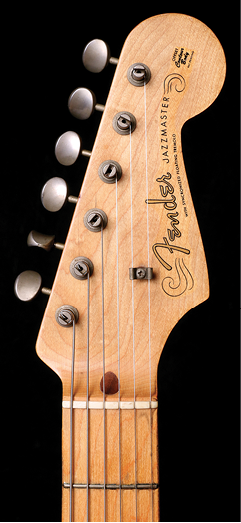12
One of my reasons for laying down stakes here in Los Angeles was its proximity to West Coast guitar manufacturers—mainly Fender Musical Instruments. As the years went on, I picked up many outstanding and unique instruments but was disappointed that I had never gotten anything directly from the “source in the day.”
All that changed one day in 1988, when I received a call from a gentleman who was looking to sell some old Fender amps for a fair price. I told him I certainly was very interested. He said his name was Ernest Tavares. Immediately, I felt my pulse quicken!
Any student of Fender knows that brothers Freddie and Ernest Tavares, along with Doc Kauffman, Leo Fender, and a few others, were the original founders of the Fender Electric Musical Instrument Manufacturing Company, back in 1946. It was believed that the brothers were instrumental in the development and design of many of Fender’s most iconic models, including the Stratocaster. They were long-time employees and valuable associates of Leo Fender. As musicians themselves, they used to frequent nightclubs and concerts to gather input from local musicians on Fender’s innovative designs, and I believe that is part of the reason why those early designs are so enduring—because they’re practical as well as beautiful.
What Ernest was selling was a pre-CBS Fender Super Reverb amp and an early Tweed Princeton amp. I assured him that I was aware of who he was, and I would be happy to buy his amps and, as a matter of fact, I’d pay decent money for whatever equipment he wanted to sell. Still sporting his native Hawaiian tan and irrepressible manner, Ernest came by and we closed the deal, all the while talking about the early days of Fender. You have to remember that the late eighties was the era of “hair bands” and Marshall-oriented high-gain EL-84 amps. Ernest’s modest 6V6 tweeds were out of style. I think he found it satisfying that I was aware of who he was and was so intrigued by his contribution to the Fender company.
I must have made an impression because a few weeks later, I got a call from Ernest’s younger brother, Freddie. Freddie had been an accomplished guitar player, as well as a very successful steel guitar player. As a matter of fact, it became known years later that he had played the steel heard at the beginning of all the Warner Brothers’ Looney Tunes The Bugs Bunny Show cartoons! That means we all grew up listening to Freddie Tavares. After a pleasant phone call, Freddie invited me to his house, down in the Long Beach area.
When I arrived at his modest home, I casually looked around to see if any of his collection was lying around. Like most musicians, he had a bunch of equipment he’d gathered over the years, but it wasn’t immediately noticeable. The first thing he pulled out was an early Rickenbacker frying pan steel guitar. These were some of the first electric guitars ever made and supposedly an influence on Leo Fender, as well as solidbody pioneer Paul Bigsby. As I examined the Rick, I caught a glimpse of a Fender Jazzmaster guitar sitting out of its case behind Freddy’s tattered couch. I could only see the top of the guitar’s headstock from where I was standing, but I could feel something was different. When he dug the guitar out from behind the couch, I saw it had several unique features. Most unusual was the guitar’s maple neck. I had only seen them with rosewood fingerboards. Two other details were the black anodized pickguard and the desert-sand finish most commonly used on early Musicmasters and Duosonics.


Fender 1958 Jazzmaster. (Photos by Jen Angkahan)
When I asked Freddie about these unusual features, he said, “This was one of the very first Jazzmasters. It’s either the first or second ever made.” He said they were still trying to decide on what features would be made as standard design. He liked the desert-sand finish and he thought the black anodized guard would be a good contrast to the body finish. He said he preferred the maple neck, but at the time of the guitar’s build, they were just introducing necks with a rosewood fingerboard. This guitar had a one-piece all-maple neck like the original Telecaster-style guitars, as well as the early Stratocasters, Musicmasters, and Duosonics.
Because the company was very high on the new rosewood fingerboards that were applied on top of the maple necks, it was decided that all production guitars would have these rosewood fingerboards. Freddie loved my enthusiasm and told me he wanted me to own the guitar—for a price of $2,500. I told him that I would be happy to pay that, which was higher than any Jazzmaster had ever gone for at that time. Today this seems to be an insignificant amount, but at the time it seemed to be hugely overpriced. Believe it or not, back then, Sunburst Les Pauls from the late fifties were going for $10,000 to $12,000, so $2,500 was a lot for a Jazzmaster.
Freddie also pulled out a prototype guitar that he had, a Fender Swinger body with Marauder appointments and a maple neck with a pointed headstock. What made the Marauder design unusual was that the pickups were hidden underneath the pickguard (no pickups visible). The Marauder never really went into production, and there were a few variants on the design. I did see one once with pickups that were exposed. The guitar has a black anodized pickguard with numerous switches on top. Freddie told me that he personally finished the body in black. This again was a guitar that did not exist and never went into production. Of course I purchased the Swinger/Marauder from Freddie as well.
We spoke for a couple hours and, because I was such a fan of the company, he informed me that he also had numerous letters written from him to Leo regarding guitar design, as well as some sample decals from later guitars such as Broncos, Lead I and II, and a few others. He said he was contemplating throwing these out, but if I was interested he would give them to me. Needless to say, I said yes, and still have these letters and decals, as well as the Jazzmaster and the Swinger/Marauder guitar, to this day.
These priceless artifacts are important parts of my personal collection. When I first acquired the Rickenbacker steel guitar, I didn’t have much love for any steel guitar, and I sold it shortly afterward. Back then, I didn’t even know too much about Freddie’s history as a renowned steel guitar player. I’m not even sure if I let the buyer know that it once belonged to Freddie Tavares. Sadly, some time later, after Freddie had passed away, I was contacted by someone from his family asking if they could buy back the Rickenbacker frying pan because that was the instrument he mostly used, and it meant a lot to them. Unfortunately I had to let them know that it was long gone and that I was very sorry about that.
The history of music often goes in trends. The lap steel guitar might as well have been an accordion in the eighties metal years. Only lately has the interest in the history of roots music picked up, and people have researched many important players in the genre. Freddie was that and much more. I knew he was a key figure, but it didn’t remove my blinders in preferring the Fender solidbody electrics to his early Rickenbacker steel guitar.
In my history as a guitar dealer, sometimes I have sold things a little too quickly, which I later regretted. I didn’t realize what an important piece of music memorabilia I had in my possession—perhaps a missing link in the chain of early lap steel solidbodies that led to the Stratocaster and beyond.